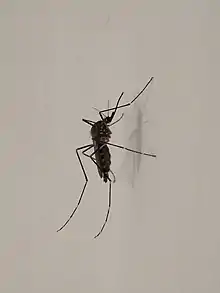Aedes koreicus
Aedes koreicus is a mosquito species originally described from Korea[1] that has been shown to be enzootic to Japan, northeastern China, the Republic of Korea (South Korea) and parts of Russia,[2] but recently found in Belgium, Italy [3] and Germany.[4] Adult Aedes koreicus are relatively large, with areas of white scales on black background, strongly resembling Aedes japonicus, which has also become established outside its native range.[2]
| Aedes koreicus | |
|---|---|
 | |
| Aedes koreicus in Trentino-South Tyrol (Italy) | |
| Scientific classification | |
| Kingdom: | |
| Phylum: | |
| Class: | |
| Order: | |
| Family: | |
| Genus: | |
| Subgenus: | Finlaya |
| Species: | Ae. koreicus |
| Binomial name | |
| Aedes koreicus (Edwards, 1917) | |
Bionomics
Aedes koreicus larvae have been found breeding in artificial water collection sites such as garden ponds, water drums, manholes, buckets, flower pots, discarded tires, and other water-containing vessels, as well as in natural collection sites such as tree holes, stone cavities, road tracks, and ditches, in either clear or organics-rich water.[2] These characteristics adapt it to surviving transport over long distances and exploiting urban as well as periurban habitats.[2]
The first documentation of Aedes koreicus becoming established outside its native range was in Belgium in 2008, marking it as an invasive species capable of being globally transported.[5] In 2011 it was discovered to be established in the Province of Belluno, Veneto region, Italy[6] and in 2013 in the Swiss-Italian border region.[7] Given its demonstrated ability to survive northern European winters and benefit from human-aided transport, the species may be introduced and become established in other temperate countries with similar climates to those where it has already become established.[2][8]
Medical Importance
Aedes koreicus adults feed on humans, domestic animals, and farm animals during day and night hours[2] and have been demonstrated to be competent vectors of Japanese encephalitis virus and dog heartworm, and a potential vector of other arboviruses, and Brugia malayi, which causes lymphatic filariasis.[2][6][7]
References
- F. W. Edwards. Notes on Culicidae, with Descriptions of New Species. Bulletin of Entomological Research, 7: 201-229; 212-213; http://www.mosquitocatalog.org/files/pdfs/039100-17.pdf Archived 2016-03-19 at the Wayback Machine.
- European Centre for Disease Prevention and Control (ECDC): Aedes koreicus, http://ecdc.europa.eu/en/healthtopics/vectors/mosquitoes/Pages/aedes-koreicus.aspx#sthash.3mOyNNJW.dpuf Archived 2016-03-19 at the Wayback Machine, accessed 15 Mar 2016.
- Thomas V. Gaffigan, Richard C. Wilkerson, James E. Pecor, Judith A. Stoffer and Thomas Anderson. 2016. "Aedes (Fin.) koreicus" in Systematic Catalog of Culicidae, Walter Reed Biosystematics Unit, http://wrbu.si.edu/SpeciesPages_non-ANO/non-ANO_A-hab/AEkor_hab.html Archived 2016-03-19 at the Wayback Machine, accessed 16 Mar 2016.
- Steinbrink, A., Zotzmann, S., Cunze, S. et al. Parasitol Res (2019) 118: 1073. https://doi.org/10.1007/s00436-019-06232-x
- Veerle Versteirt, James Pecor, Dina Madeira Fonseca, Marc Coosemans, and Wim Van Bortel. 2012. Confirmation of Aedes koreicus (Diptera: Culicidae) in Belgium and description of morphological differences between Korean and Belgian specimens validated by molecular identification. Zootaxa, 3191(3191):21-32; https://www.researchgate.net/publication/263086955_Confirmation_of_Aedes_koreicus_Diptera_Culicidae_in_Belgium_and_description_of_morphological_differences_between_Korean_and_Belgian_specimens_validated_by_molecular_identification.
- Capelli, Gioia; Drago, Andrea; Martini, Simone; Montarsi, Fabrizio; Soppelsa, Mauro; Delai, Nicola; Ravagnan, Silvia; Mazzon, Luca; Schaffner, Francis; Mathis, Alexander; Di Luca, Marco; Romi, Roberto; Russo, Francesca (2011). "First report in italy of the exotic mosquito species Aedes (Finlaya) koreicus, a potential vector of arboviruses and filariae". Parasites & Vectors. 4: 188. doi:10.1186/1756-3305-4-188. PMC 3203849. PMID 21951867.
- Tobias Suter, Eleonora Flacio, Begoña Feijoó Fariña, Lukas Engeler, Mauro Tonolla and Pie Müller. 2015. First report of the invasive mosquito species Aedes koreicus in the Swiss-Italian border region. Parasites & Vectors, 8:402 (4 pp.), http://parasitesandvectors.biomedcentral.com/articles/10.1186/s13071-015-1010-3.
- Marcantonio, Matteo; Metz, Markus; Baldacchino, Frédéric; Arnoldi, Daniele; Montarsi, Fabrizio; Capelli, Gioia; Carlin, Sara; Neteler, Markus; Rizzoli, Annapaola (3 February 2016). "First assessment of potential distribution and dispersal capacity of the emerging invasive mosquito Aedes koreicus in Northeast Italy". Parasites & Vectors. 9 (1). doi:10.1186/s13071-016-1340-9. PMC 4739402.
